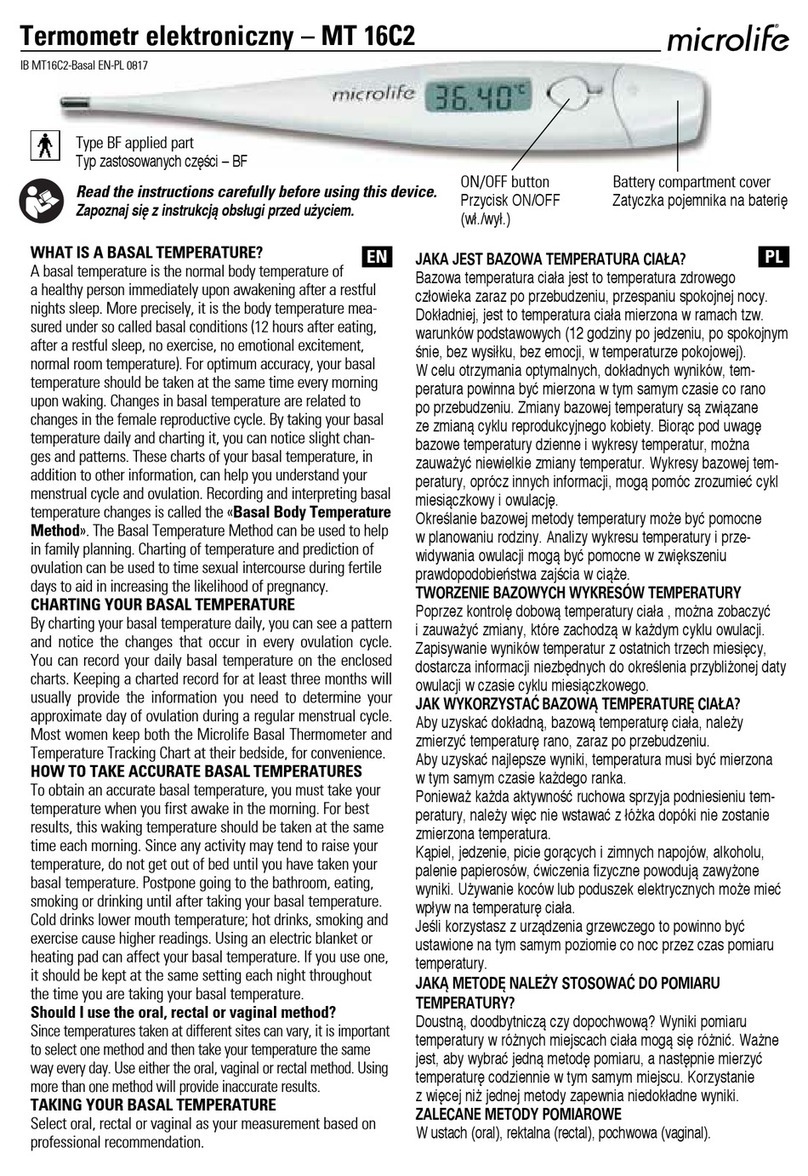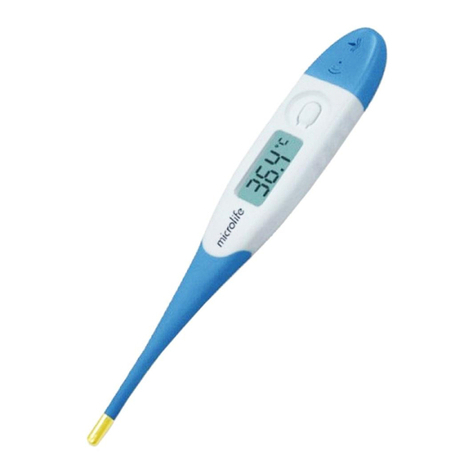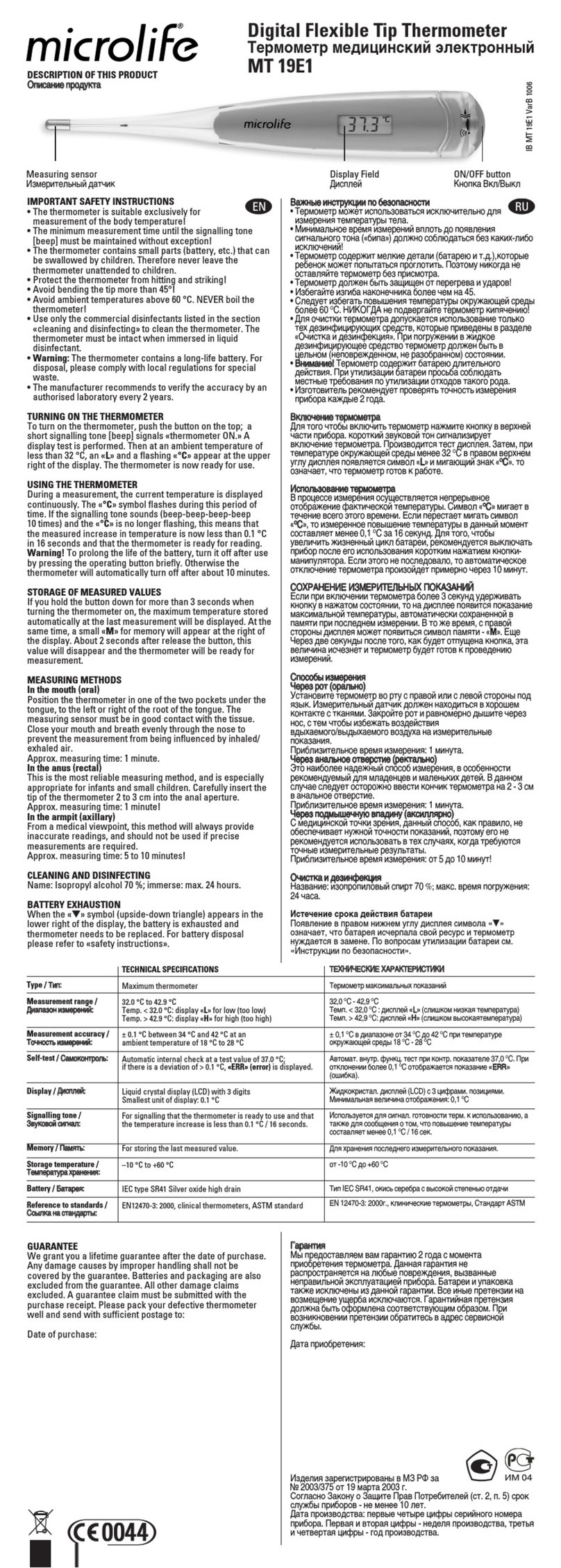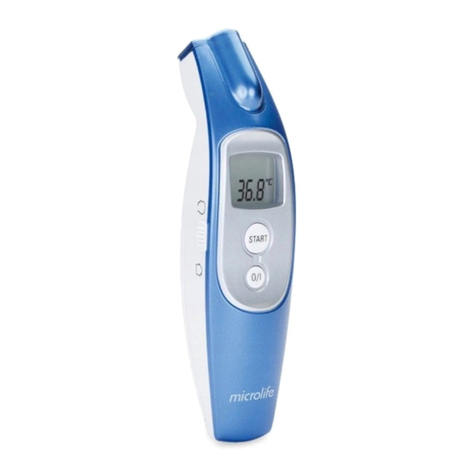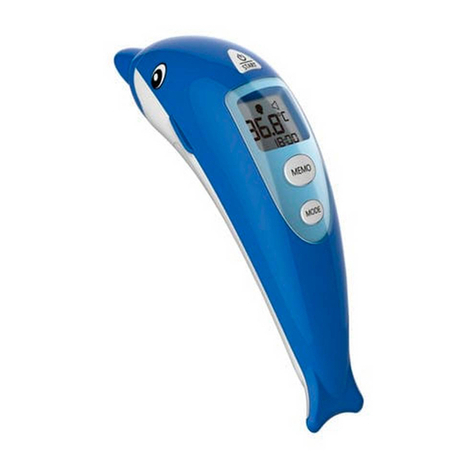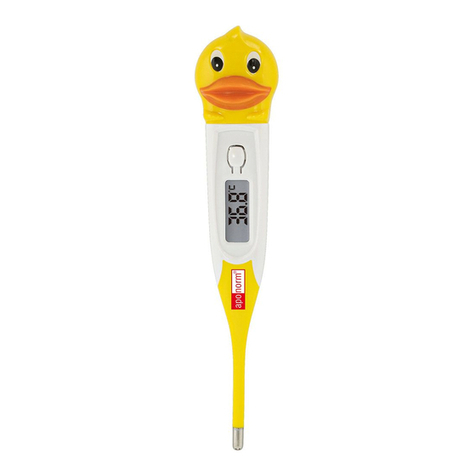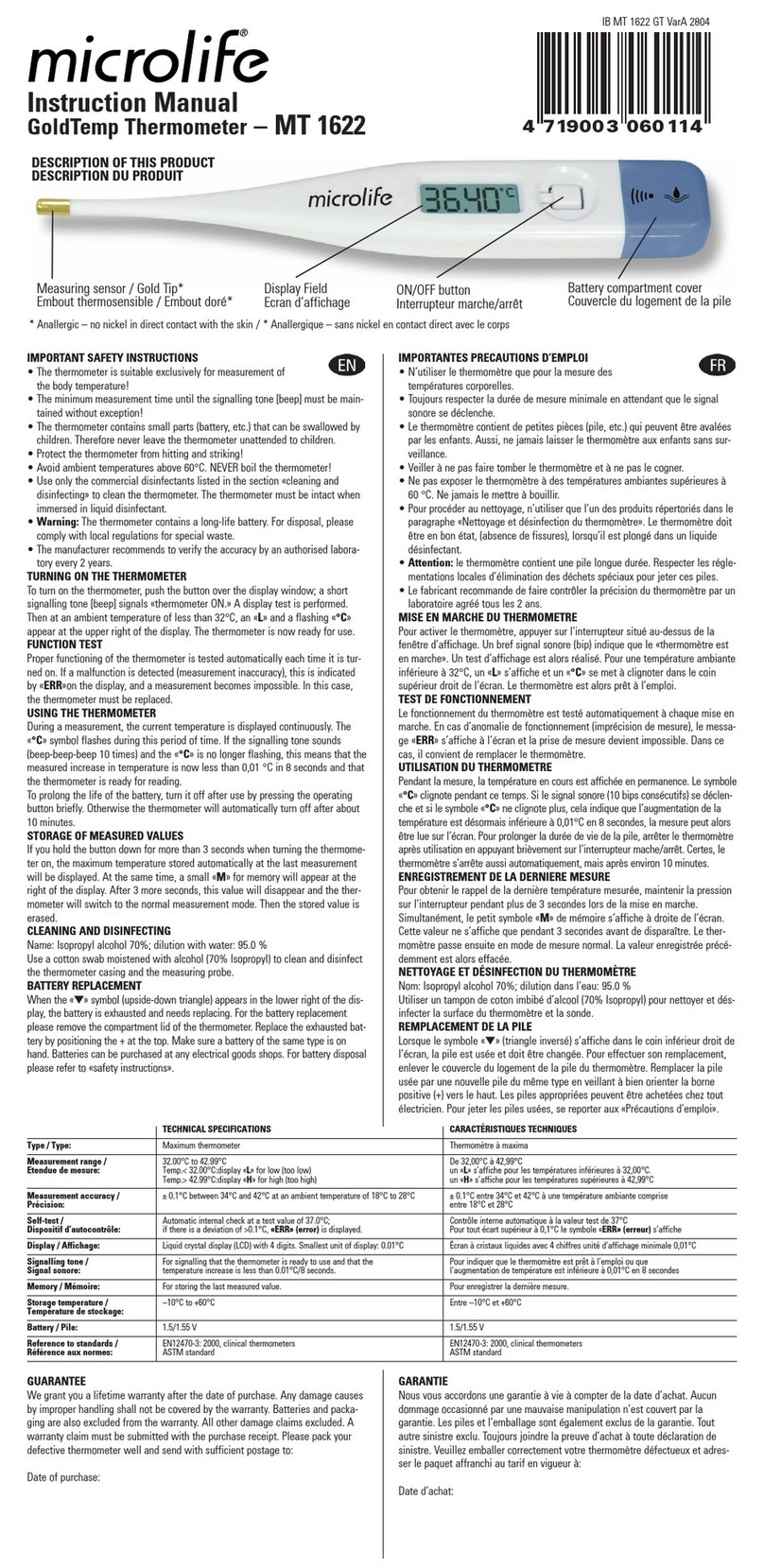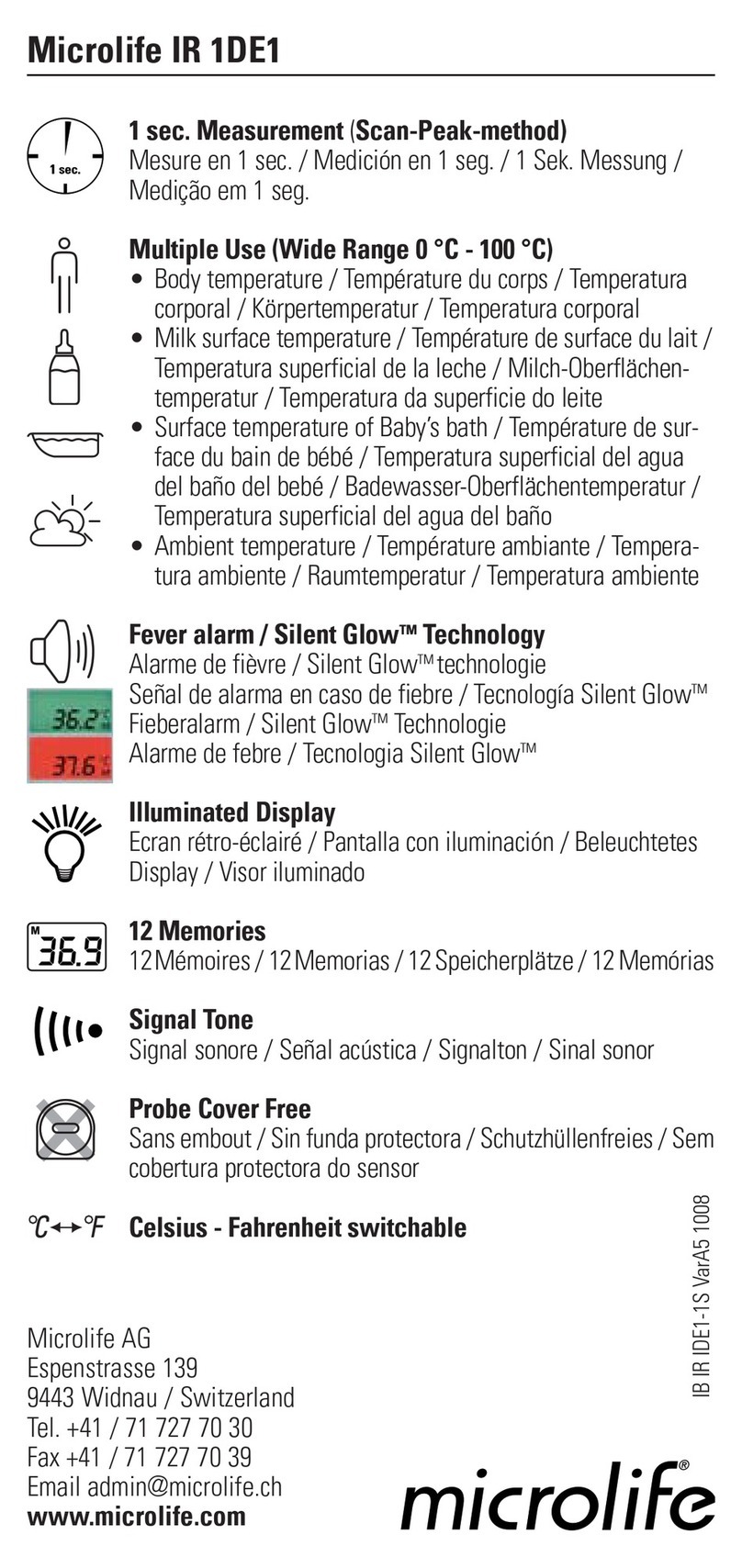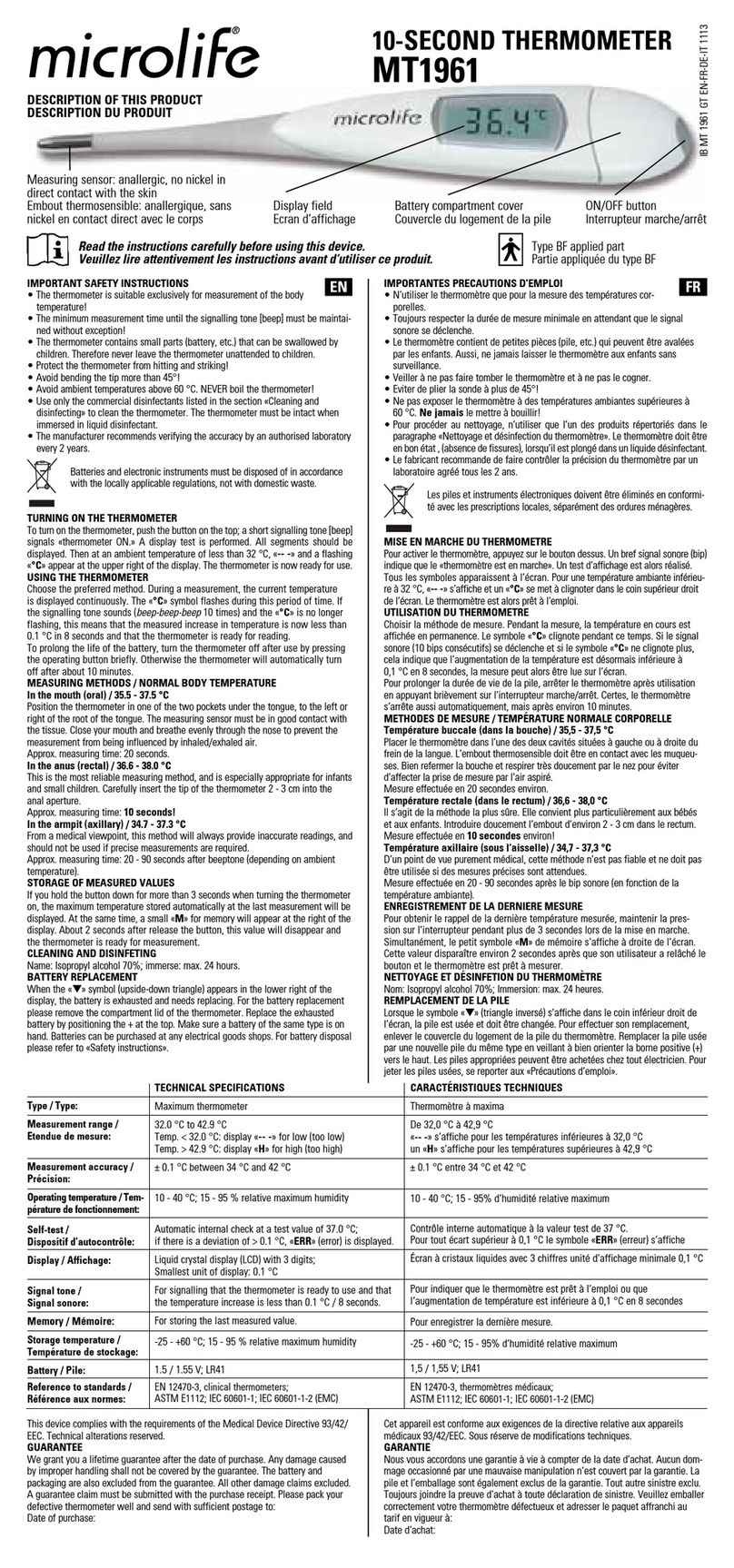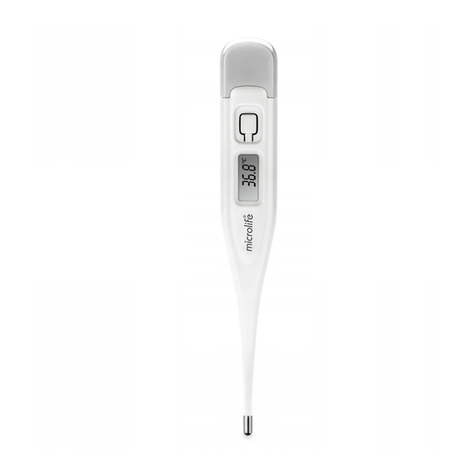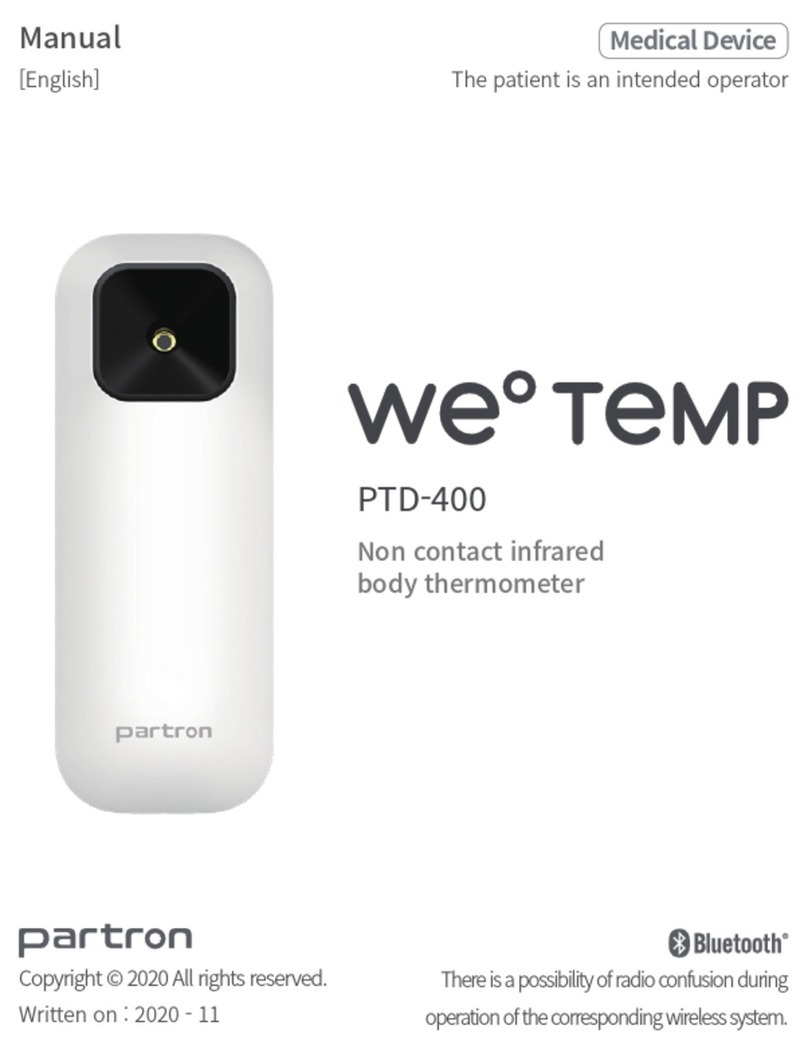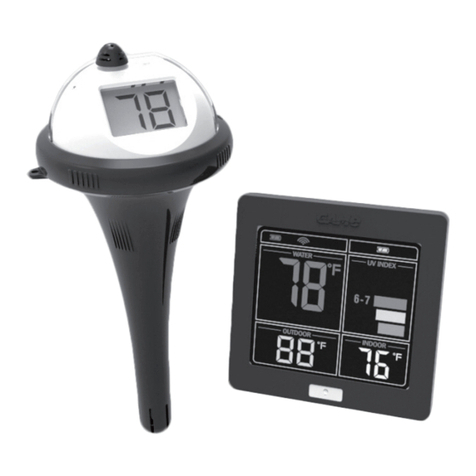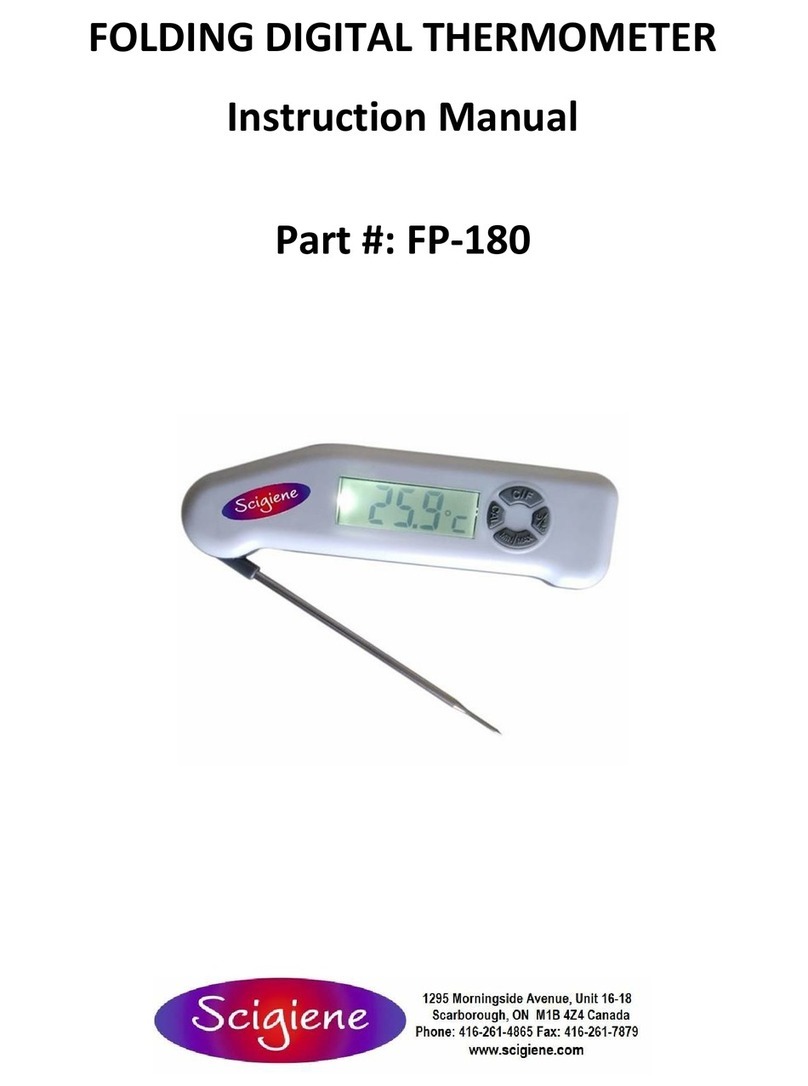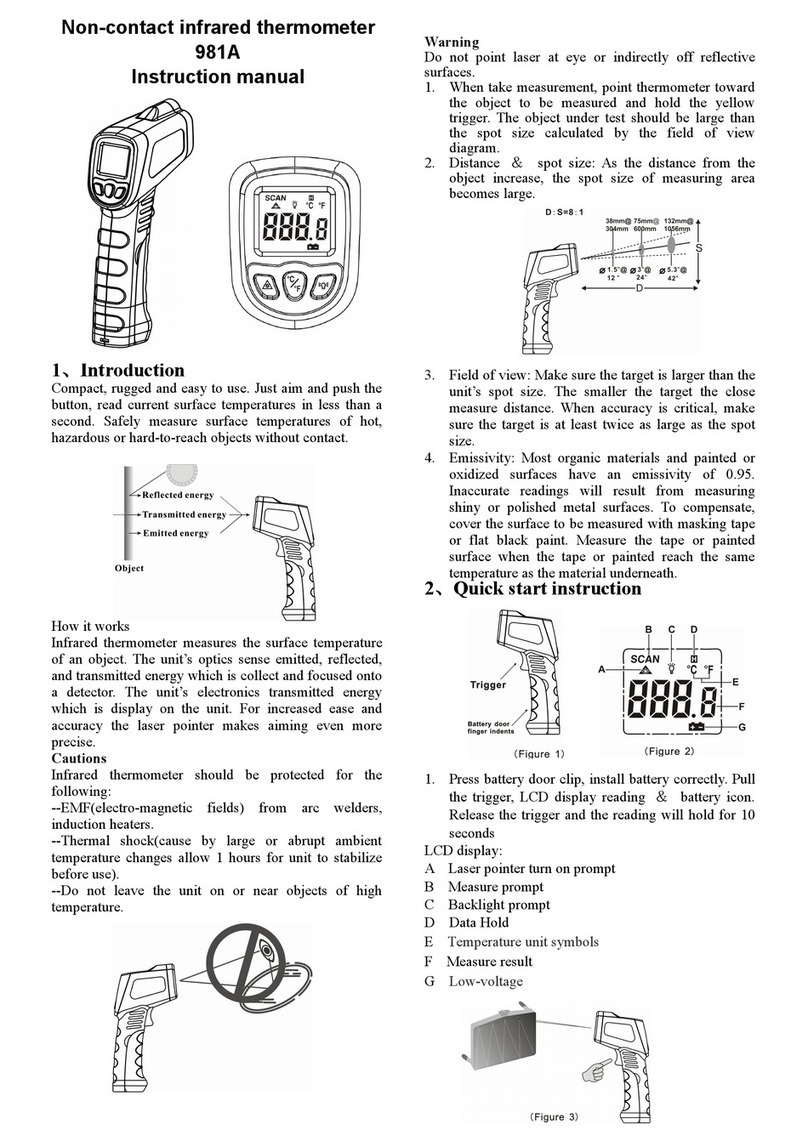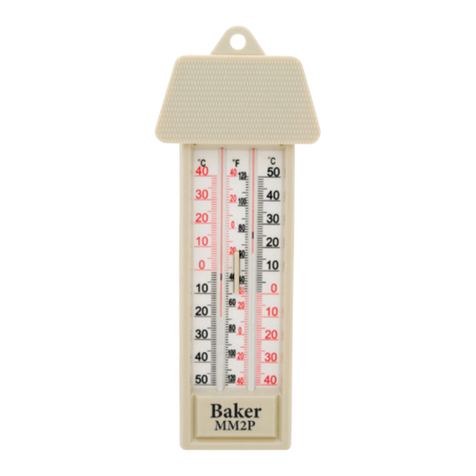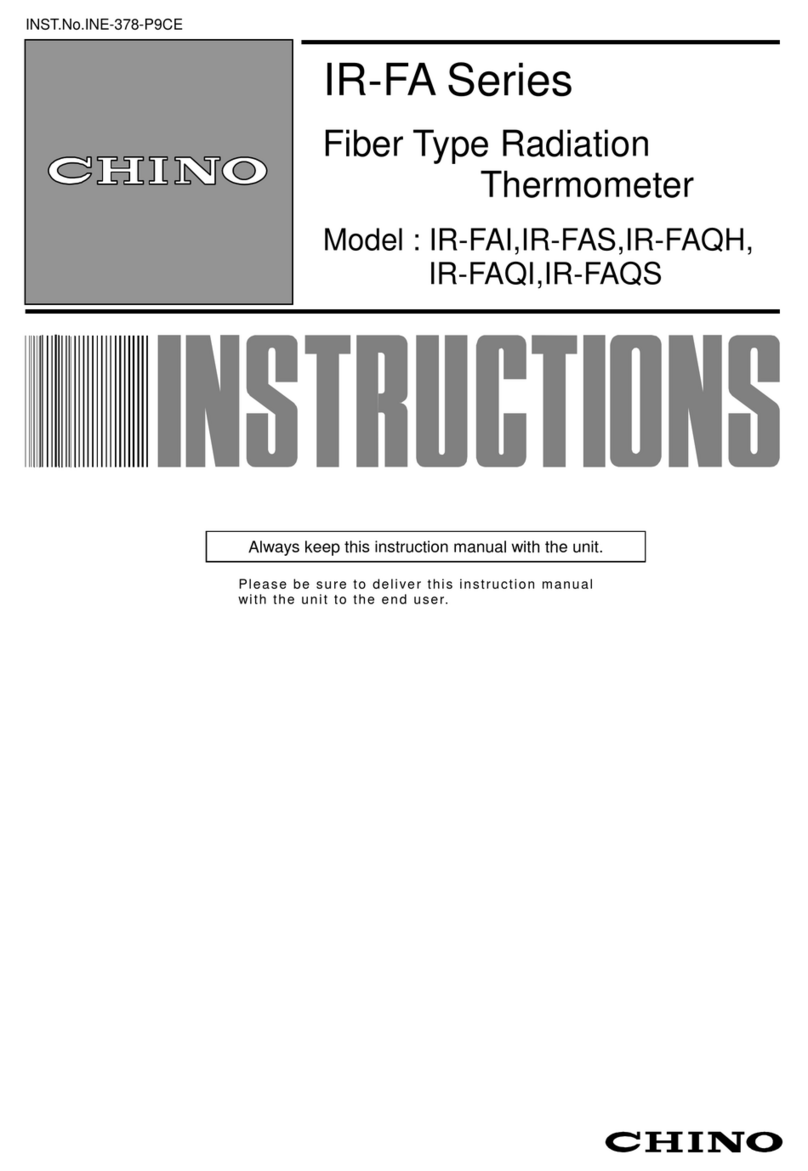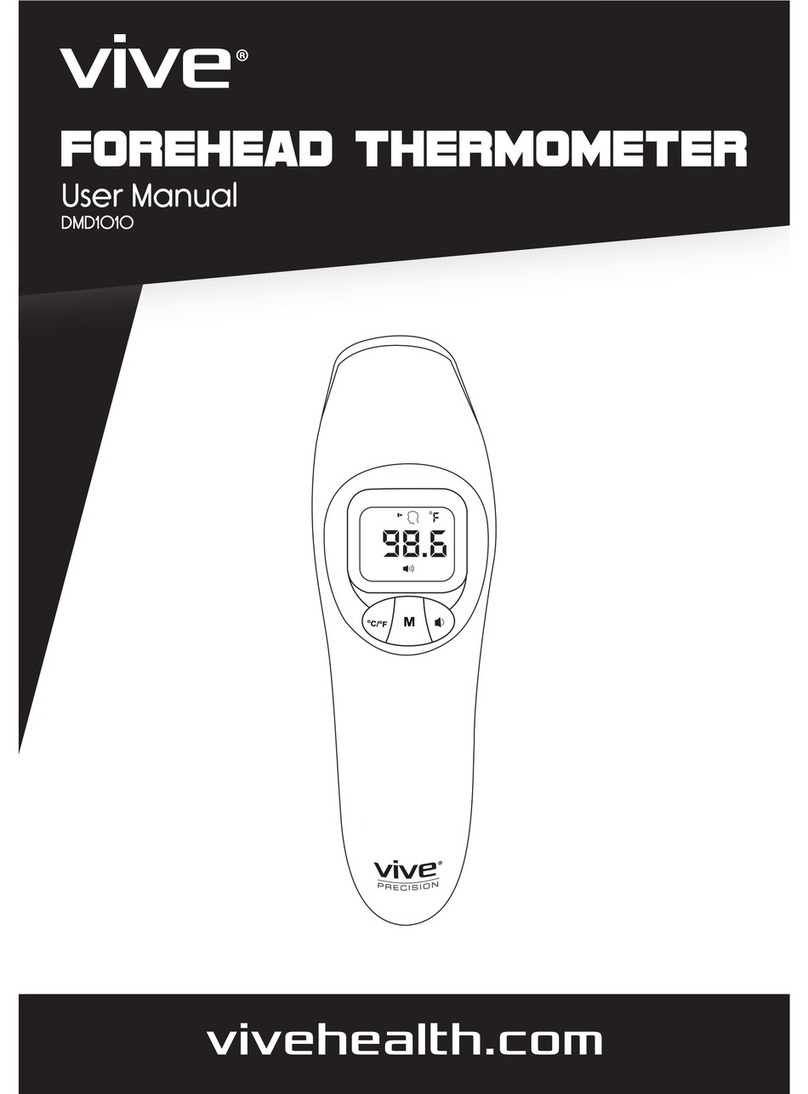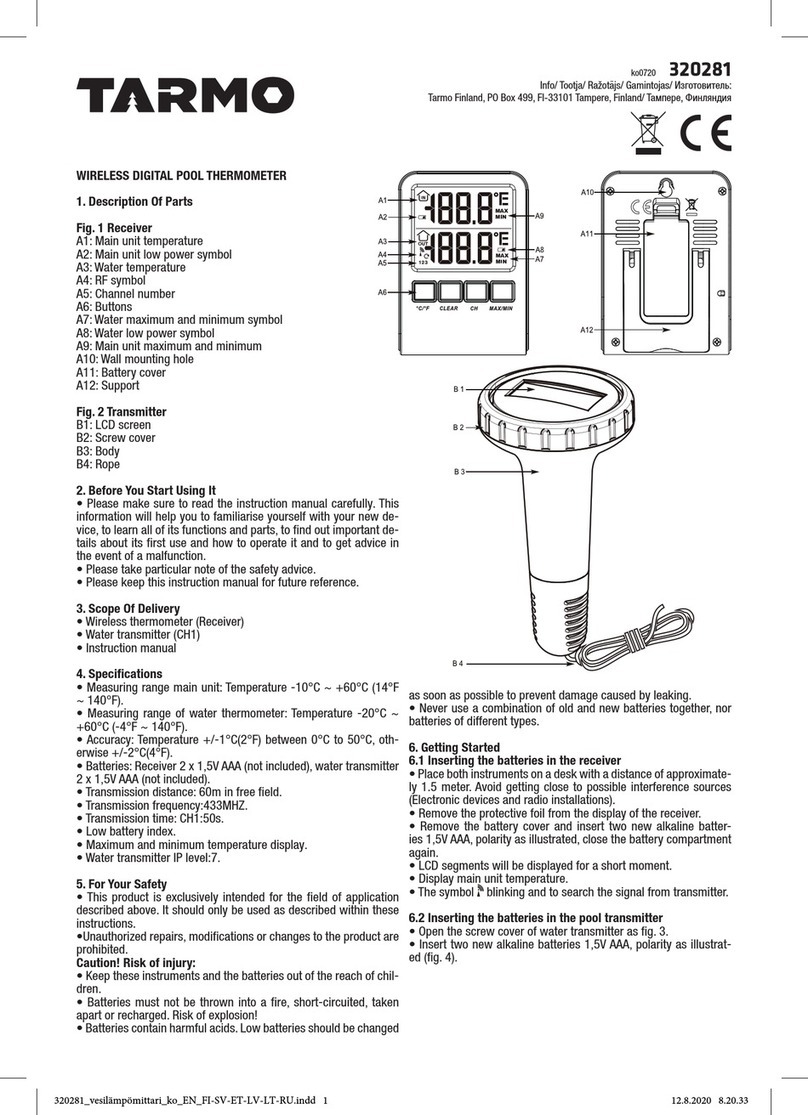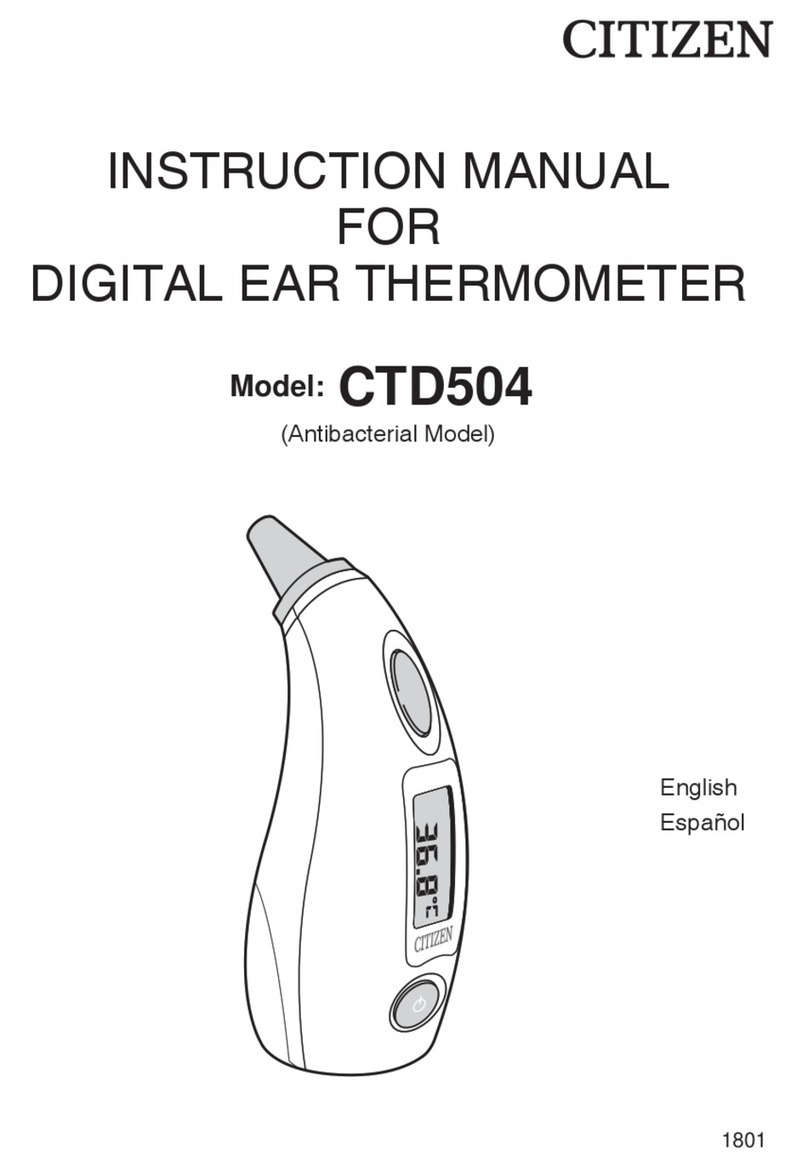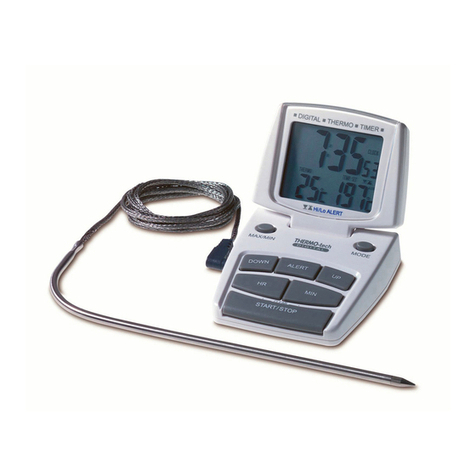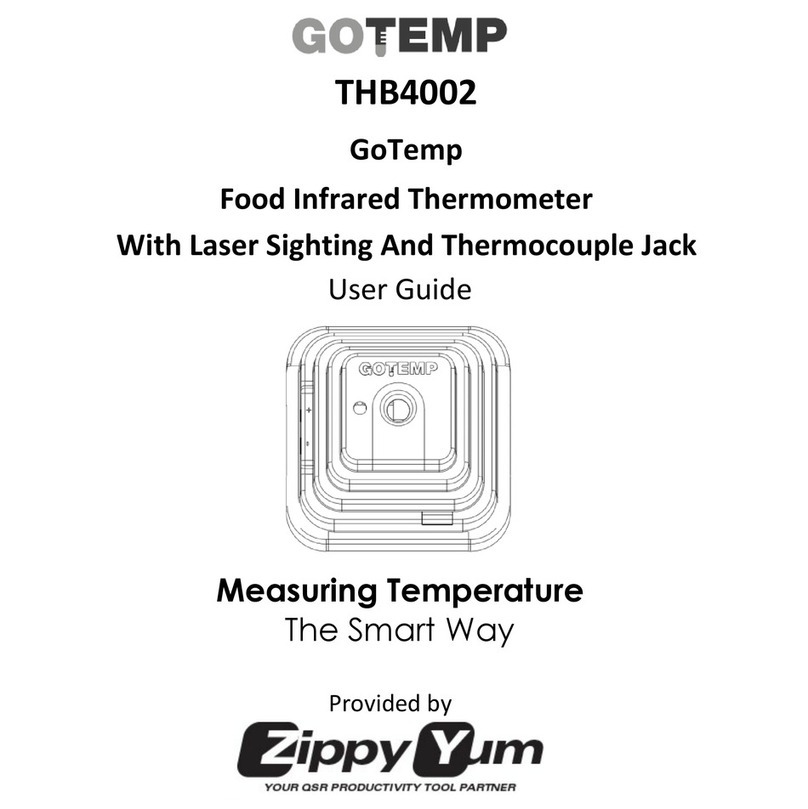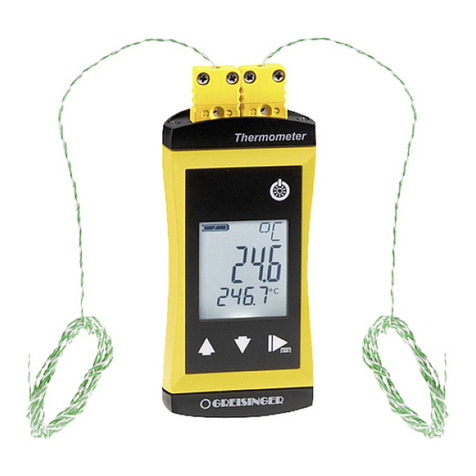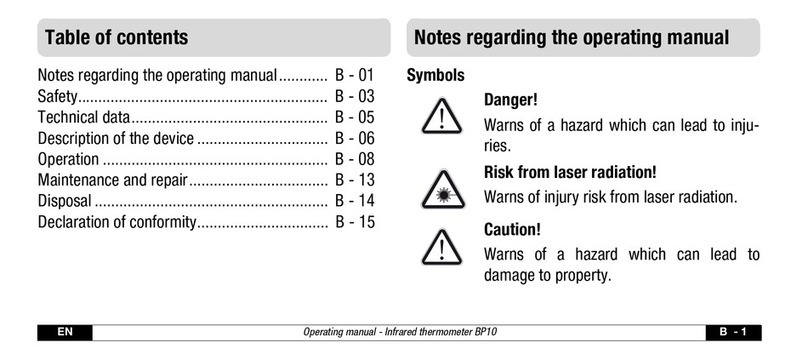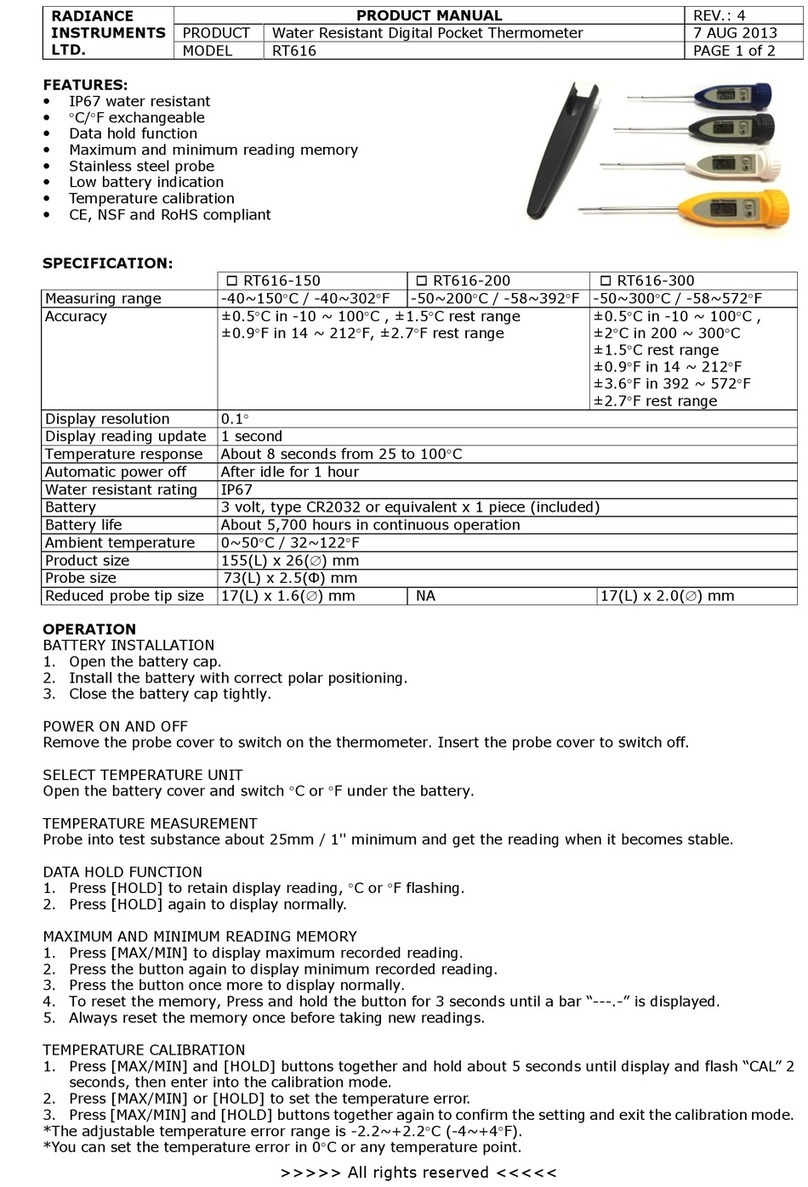
MT 60
IB MT 60 EN-FR-PT-AR 3119
Description of this Thermometer
Important Safety Instructions
Follow instructions for use. This document provides important
product operation and safety information regarding this device.
Please read this document thoroughly before using the device and
keep for future reference.
The instrument may be used only for measuring body temperature!
The minimum measurement time until the beep is heard must be
maintained without exception!
The battery is well sealed inside the thermometer to reduce the risk
to be swallowed by children.
Do not use this device close to strong electromagnetic fields such as
mobile telephones or radio installations. Keep a minimum distance
of 3.3 m from such devices when using this device.
Protect the instrument from impact and dropping!
Avoid ambient temperatures above 60 °C. NEVER boil the instrument!
Use only the commercial disinfectants listed in the section«Cleaning
and Disinfecting» to clean the instrument. The instrument must be
intact when immersed in liquid disinfectant.
We recommend this instrument is tested for accuracy every two
years or after mechanical impact (e.g. being dropped). Please
contact Microlife-Service to arrange the test.
WARNING: The measurement result given by this device is
not a diagnosis! Do not rely on the measurement result only.
Batteries and electronic devices must be disposed of in
accordance with the locally applicable regulations, not with
domestic waste.
Read the instructions carefully before using this device.
Type BF applied part
Turning on the Thermometer
To turn on the thermometer, press the ON/OFF button 1; a short
beep signals «thermometer ON». A display test is performed. All
segments should be displayed.
Then at an ambient temperature of less than 32 °C, an «L» and a
flashing «°C» appear at the display field 2. The thermometer is now
ready for use.
Function Test
Correct functioning of the thermometer is tested automatically each
time it is turned on. If a malfunction is detected (measurement inaccu-
racy), this is indicated by «ERR» on the display, and a measurement
becomes impossible. In this case, the thermometer must be replaced.
Using the Thermometer
Choose the preferred measuring method. When taking a measure-
ment, the current temperature is continuously displayed and the «°C»
symbol flashes. If the beep is heard 10 times and the «°C» is no longer
flashing, this means that the measured increase in temperature is less
than 0.1 °C in 16 seconds and that the thermometer can now be read.
To prolong the battery life, turnoff the thermometer by briefly pressing
the ON/OFF button 1. Otherwise the thermometer will automatically
turn off after about 10 minutes.
Storage of Measured Values
If the ON/OFF button 1is pressed for more than 3 seconds when
turning on the thermometer, the automatically stored maximum
temperature during the last measurement will be displayed. At the
same time, a «M» for memory will appear on the display. About
2 seconds after the button is released, the temperature value disap-
pears and the thermometer is ready for measurement.
Measuring methods / Normal body temperature
In the mouth (oral) / 35.5 - 37.5 °C
Position the thermometer in one of the two pockets under the
tongue, to the left or right of the root of the tongue. The measuring
sensor 3must be in good contact with the tissue. Close your mouth
and breathe evenly through the nose to prevent the measurement
from being influenced by inhaled/ exhaled air.
Approx. measuring time: 1 minute!
In the anus (rectal) / 36.6 - 38.0 °C
This is the most reliable measuring method, and is especially suit-
able for infants and small children. Carefully insert the measuring
sensor 3of the thermometer 2 to 3 cm into the anal aperture.
Approx. measuring time: 1 minute!
In the armpit (axillary) / 34.7 - 37.3 °C
To receive more reliable results we recommend measuring tempera-
ture orally or rectally. A minimum measurement time of 5-10 minutes
is recommended regardless of the beep sound.
Cleaning and Disinfecting
Name: Isopropyl alcohol 70 %; immerse: max. 24 hours.
Battery Exhaustion
When the «» symbol (upside-down triangle) appears on the right
side of the display, the battery is exhausted and the thermometer
needs to be replaced. For battery disposal please refer to «Important
Safety Instructions».
Technical Specifications
This device complies with the requirements of the Medical Device
Directive 93/42/EEC.
Technical alterations reserved.
Guarantee
We grant you a lifetime guarantee after the date of purchase. Any
damage caused by improper handling shall not be covered by the guar-
antee. The battery and packaging are excluded from the guarantee. All
other damage claims excluded. A guarantee claim must be submitted
with the purchase receipt. Please pack your defective instrument well
and send with sufficient postage to the
Microlife
distributor.
1ON/OFF button
2Display
3Measuring sensor
Type: Maximum thermometer
Measurement range: 32.0 °C to 43.9 °C
Temp. < 32.0 °C: display «L» for low (too low)
Temp. > 43.9 °C: display «H» for high (too high)
Measurement accuracy: ± 0.1 °C between 34 °C and 42 °C
Operating conditions: 10 - 40 °C; 15-95 % relative maximum humidity
Storage conditions: -25 - +60 °C; 15-95 % relative maximum humidity
Battery: 1.5/1.55 V; LR41
Battery lifetime: approx. 4500 measurements (using a new battery)
IP Class: IP67
Reference to
standards:
EN 12470-3, clinical thermometers;
ASTM E1112; IEC 60601-1; IEC 60601-1-2 (EMC);
IEC 60601-1-11
Expected service life: 5 years or 10000 measurements
Microlife AG, Espenstrasse 139
9443 Widnau / Switzerland
Description du thermomètre
Importantes précautions d'emploi
Respectez les instructions d’utilisation. Ce document fournit des
informations importantes sur le fonctionnement et la sécurité de cet
appareil. Veuillez lire attentivement ce document avant d'utiliser
l'appareil et conservez-le pour vous y référer ultérieurement.
L'instrument ne convient qu'à la mesure de la température corporelle.
Toujours respecter la durée minimale de mesure en attendant que
le bip retentisse.
La pile est parfaitement scellée dans le thermomètre pour réduire le
risque d’être avalée par les enfants.
Ne mettez pas l'appareil en service dans un champ électromagnétique
de grande intensité, par exemple à proximité de téléphones portables
ou d'installations radio. Garder une distance minimale de 3,3 mètres
de ces appareils lors de toute utilisation.
Ne pas exposer l'instrument à des températures ambiantes supé-
rieures à 60 °C. Ne JAMAIS faire bouillir l'instrument!
Pour procéder au nettoyage, n'utiliser que les désinfectants réperto-
riés dans le paragraphe «Nettoyage et désinfection». L'instrument
doit être en bon état (absence de fissures) lorsqu'il est plongé dans
un liquide désinfectant.
Nous recommandons de faire contrôler la précision de cet instrument
tous les deux ans ou après un choc mécanique (par ex. chute).
Veuillez contacter le Service
Microlife
pour convenir d'une révision.
ATTENTION: La mesure délivrée par ce thermomètre ne
constitue pas un diagnostic! Ne pas se fier uniquement au
résultat de la mesure.
Les piles et appareils électroniques doivent être éliminés en
conformité avec les prescriptions locales, séparément des
ordures ménagères.
Veuillez lire attentivement les instructions avant d'utiliser ce
produit.
Partie appliquée du type BF
Mise en marche du thermomètre
Pour activer le thermomètre, appuyer sur le bouton ON/OFF
1
. Un bref
bip indique que le «thermomètre est en marche». Un test d'affichage est
alors réalisé. Tous les symboles apparaissent à l'écran.
Pour une température ambiante inférieure à 32 °C, un «L» s'affiche et
un «°C» se met à clignoter sur l’écran 2. Le thermomètre est alors
prêt à l'emploi.
Test de fonctionnement
Le fonctionnement du thermomètre est testé automatiquement à chaque
mise en marche. En cas d'anomalie de fonctionnement (imprécision de
mesure), le message
«ERR»
s'affiche et la prise de mesure devient
impossible. Dans ce cas, il convient de remplacer le thermomètre.
Utilisation du thermomètre
Choisir la méthode de mesure. Pendant une mesure, la température en
cours est affichée en permanence et le symbole
«°C»
clignote. Si le bip
retentit 10 fois et si le
«°C»
ne clignote plus, l'augmentation de tempéra-
ture est inférieure à 0.1 °C en 16 secondes. La mesure peut alors être lue.
Pour prolonger la durée de vie de la pile, arrêter le thermomètre en
appuyant brièvement sur le bouton ON/OFF
1
.Cependantle thermomètre
s'arrêtera automatiquement au bout d'environ 10 minutes de non utilisation.
Enregistrement de la dernière mesure
Pour obtenir le rappel de la dernière température mesurée (max.),
maintenir le bouton ON/OFF 1enfoncé pendant plus de 3 secondes
lors de la mise en marche. Simultanément le petit symbole «M» de
mémoire s'affiche. Cette valeur ne s'affiche que pendant 2 secondes.
Après, le thermomètre est prêt à mesurer.
Méthodes de mesure / Température normale corporelle
Température buccale (dans la bouche) / 35.5 - 37.5 °C
Placer le thermomètre dans l'une des deux cavitéssituées à gauche
ou à droite du frein de la langue. L'embout thermosensible 3doit
être en contact avec les muqueuses. Bien refermer la bouche et
respirer très doucement par le nez pour éviter d'affecter la prise de
mesure par l'air aspiré/expiré.
Mesure effectuée en 1 minute environ!
Température rectale (dans le rectum) / 36.6 - 38.0 °C
Il s'agit de la méthode la plus sûre. Elle convient plus particulière-
ment aux bébés et aux enfants. Introduire doucement l'embout 3
d'env. 2 à 3 cm dans le rectum.
Mesure effectuée en 1 minute environ!
Température axillaire (sous l'aisselle) / 34.7 - 37.3 °C
Pour obtenir des résultats plus fiables, nous vous recommandons de
mesurer la température de façon orale ou rectale. Un temps de
mesure minimum de 5-10 minutes est recommandé même si le bip
sonore a retentit.
Nettoyage et désinfection
Nom: Alcool isopropyl 70 %; immersion: max. 24 heures.
Déchargement de la pile
Lorsque le symbole «» (triangle inversé) apparaît au coin droit de
l’écran d'affichage, cela signifie que la pile est déchargée et que le
thermomètre doit être remplacé. Pour jeter les piles usées, se reporter
aux «Importantes précautions d'emploi».
Caractéristiques techniques
Cet appareil est conforme aux exigences de la directive relative aux
appareils médicaux 93/42/EEC.
Sous réserve de modifications techniques.
Garantie
Nous vous accordons une garantie à vie à compter de la date d'achat.
Aucun dommage occasionné par une mauvaise manipulation n'est
couvert par la garantie. La pile et l'emballage sont également exclus de la
garantie. Ainsi que tout autre sinistre. Toujours joindre la preuve d'achat
à toute déclaration de sinistre. Veuillez emballer correctement l'instrument
défectueux et adresser le paquet affranchi au tarif en vigueur à
Microlife
.
1Bouton ON/OFF (marche/arrêt)
2Écran
3Embout thermosensible
Type: Thermomètre à maxima
Plage de mesure: 32.0 °C à 43.9 °C
Un «L» s'affiche pour les températures inférieures à 32.0 °C
Un
«H»
s'affiche pour les températures supérieures à 43.9 °C
Précision: ± 0.1 °C entre 34 °C et 42 °C
Conditions
d’utilisation: 10 - 40 °C; 15-95% d'humidité relative maximum
Conditions de
stockage: -25 - +60 °C; 15-95% d'humidité relative maximum
Pile: 1.5/1.55 V; LR41
Durée de vie des
piles: env. 4500 mesures (avec une pile neuve)
Classe IP: IP67
Référence aux
normes:
EN 12470-3, thermomètres médicaux;
ASTM E1112; IEC 60601-1; IEC 60601-1-2 (EMC);
IEC 60601-1-11
Espérance de
fonctionnement: 5 ans ou 10000 mesures

